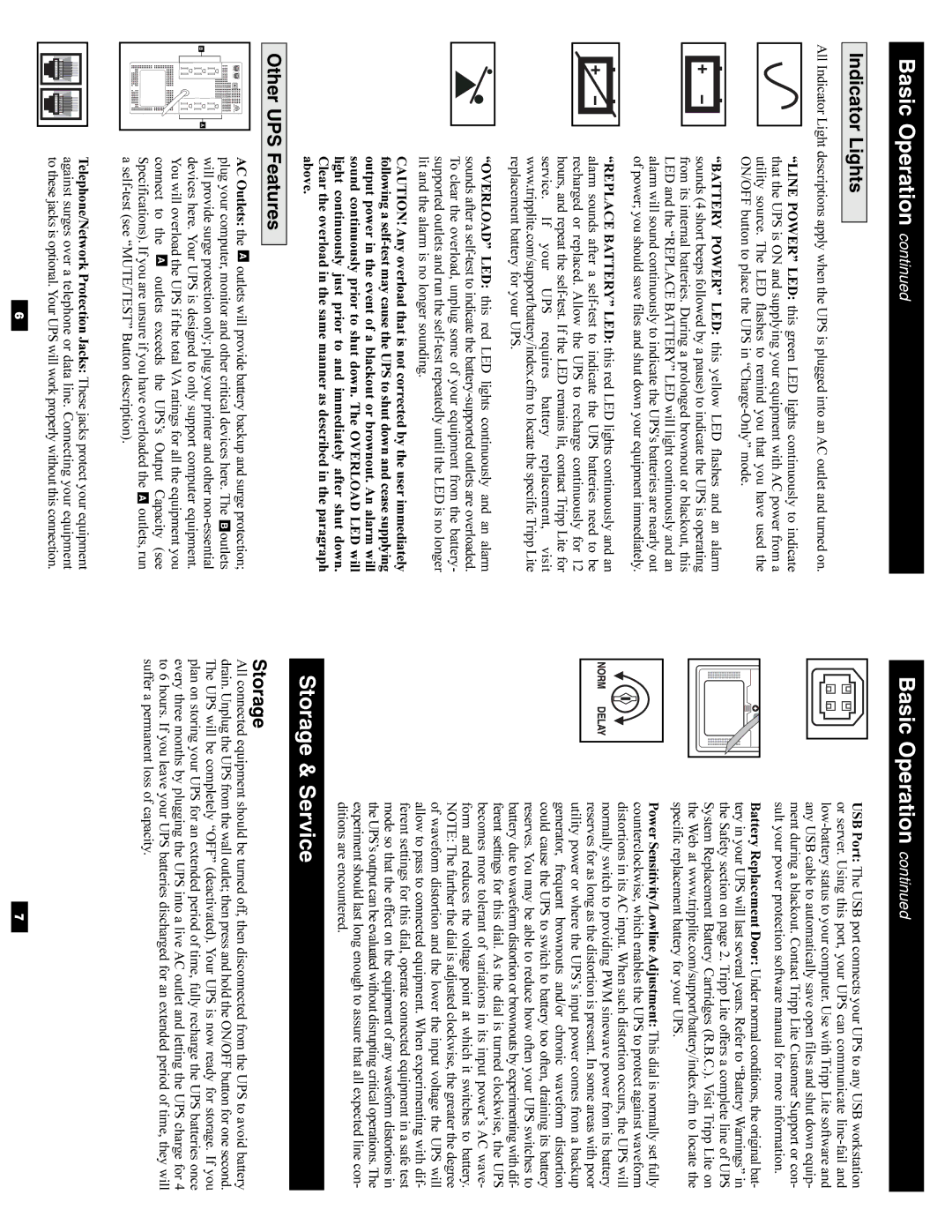
Basic Operation continued
Indicator Lights
All Indicator Light descriptions apply when the UPS is plugged into an AC outlet and turned on.
“LINE POWER” LED: this green LED lights continuously to indicate that the UPS is ON and supplying your equipment with AC power from a utility source. The LED flashes to remind you that you have used the ON/OFF button to place the UPS in
“BATTERY POWER” LED: this yellow LED flashes and an alarm sounds (4 short beeps followed by a pause) to indicate the UPS is operating from its internal batteries. During a prolonged brownout or blackout, this LED and the “REPLACE BATTERY” LED will light continuously and an alarm will sound continuously to indicate the UPS's batteries are nearly out of power; you should save files and shut down your equipment immediately.
“REPLACE BATTERY” LED: this red LED lights continuously and an alarm sounds after a
“OVERLOAD” LED: this red LED lights continuously and an alarm sounds after a
CAUTION! Any overload that is not corrected by the user immediately following a
Other UPS Features
Basic Operation continued
USB Port: The USB port connects your UPS to any USB workstation or server. Using this port, your UPS can communicate
Battery Replacement Door: Under normal conditions, the original bat- tery in your UPS will last several years. Refer to “Battery Warnings” in the Safety section on page 2. Tripp Lite offers a complete line of UPS System Replacement Battery Cartridges (R.B.C.). Visit Tripp Lite on the Web at www.tripplite.com/support/battery/index.cfm to locate the specific replacement battery for your UPS.
Power Sensitivity/Lowline Adjustment: This dial is normally set fully counterclockwise, which enables the UPS to protect against waveform distortions in its AC input. When such distortion occurs, the UPS will normally switch to providing PWM sinewave power from its battery reserves for as long as the distortion is present. In some areas with poor utility power or where the UPS’s input power comes from a backup generator, frequent brownouts and/or chronic waveform distortion could cause the UPS to switch to battery too often, draining its battery reserves. You may be able to reduce how often your UPS switches to battery due to waveform distortion or brownouts by experimenting with dif- ferent settings for this dial. As the dial is turned clockwise, the UPS becomes more tolerant of variations in its input power’s AC wave- form and reduces the voltage point at which it switches to battery. NOTE: The further the dial is adjusted clockwise, the greater the degree of waveform distortion and the lower the input voltage the UPS will allow to pass to connected equipment. When experimenting with dif- ferent settings for this dial, operate connected equipment in a safe test mode so that the effect on the equipment of any waveform distortions in the UPS’s output can be evaluatedwithout disrupting critical operations. The experiment should last long enough to assure that all expected line con- ditions are encountered.
Storage & Service
Storage
B | A |
AC Outlets: the A outlets will provide battery backup and surge protection; plug your computer, monitor and other critical devices here. The B outlets will provide surge protection only; plug your printer and other
All connected equipment should be turned off, then disconnected from the UPS to avoid battery drain. Unplug the UPS from the wall outlet; then press and hold the ON/OFF button for one second. The UPS will be completely “OFF” (deactivated). Your UPS is now ready for storage. If you plan on storing your UPS for an extended period of time, fully recharge the UPS batteries once every three months by plugging the UPS into a live AC outlet and letting the UPS charge for 4 to 6 hours. If you leave your UPS batteries discharged for an extended period of time, they will suffer a permanent loss of capacity.
Telephone/Network Protection Jacks: These jacks protect your equipment against surges over a telephone or data line. Connecting your equipment to these jacks is optional. Your UPS will work properly without this connection.
6
7
